Exercise Physiology
Exercise Physiology Research Systems and Software
Wirelessly record a range of physical parameters
Invaluable tools for in-depth study of exercise physiology and biomechanics
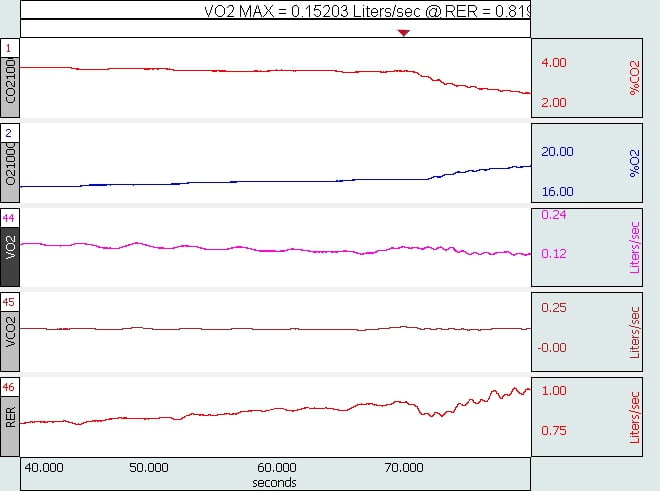
Wired, Wireless, and Logging Solutions
AcqKnowledge® is an invaluable tool for in-depth study of exercise physiology and biomechanics. Wirelessly record a range of physical parameters (body movement or exercise) with BioNomadix® or the BioHarness and TEAM systems. Examine ECG, ventilation, oxygen uptake, carbon dioxide production, blood pressure and core/surface temperature data in real-time, or analyze results in greater detail in an easy-to-read graph format. Each physiological response is recorded in a separate graph channel, with an array of measurements and viewing tools designed to optimize data analysis. Transform data in real time with the online calculation channels, or for advanced post-processing analysis, use AcqKnowledge’s powerful Automated Analysis tools. These pre-loaded, advanced algorithms enable researchers to achieve efficient standardization of results without the need for complicated equations and time consuming manual transformation processes.
Try exercise physiology research tools in the free AcqKnowledge Demo
See More...Hardware Packages | Exercise Physiology
Hardware Bundles are complete solutions for the specified application. Choose your preferred platform and bundle, then click "Request Pricing" to request an estimate, add/remove items, or complete purchase. If you have questions about specific items, click through to the product web page for details and specifications, or contact your Local Sales contact.
Wireless
-
BioNomadix Logger with Clench Force & EMG
Wireless | Exercise Physiology
BioNomadix Logger and one transmitter for wireless dynamometry & EMG, clench force transducer, 30 cm leads & disposable electrodes, plus Impedance Checker
BioNomadix Logger with Clench Force & EMG
- 1 x BioNomadix Wireless Wearable Physiology Logger
- 1 x BioNomadix Wireless Clench Force Transducer
- 1 x Electrode Leads - BioNomadix Wireless
- 1 x Cloth Base Electrodes
- 1 x Abrasive Pads 10/pk
- 1 x Electrode Impedance Checker
Animal
-
Implantable ECG
Animal | Exercise Physiology
EPOCH implantable wireless ECG system with MP160 System for long-term monitoring of pups, mice, or rats.
Implantable ECG
- 1 x Unknown Product (Array)
- 1 x Unknown Product (Array)
- 1 x EPOCH Transmitter Activation Utility
Details
Anaerobic Threshold – Use the power of AcqKnowledge to establish a ratio of inspired volume and VO2 consumption and to integrate the air flow signal to obtain total inspired volume in real time.
End Tidal CO2 – Measure end-tidal CO2 on a breath-by-breath basis. Use the AcqKnowledge Find Rate feature to find the peak of the cyclic CO2 concentration signal and export results.
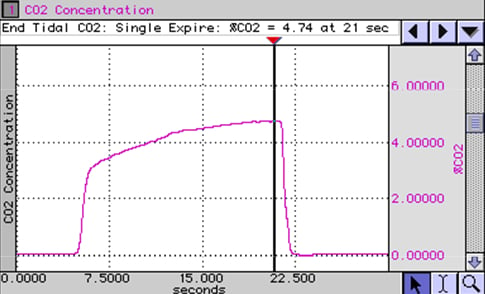
Respiratory Exchange Ratio – AcqKnowledge records RER data and a range of other metabolic signals. An automated script for computing RER is available via download from BIOPAC. (Scripting license is required)
Respiratory Gas Analysis – Use AcqKnowledge with BIOPAC’s specially-designed O2 and CO2 modules for quick, accurate respiratory gas analysis. Achieve optimized response times of 200 ms to record quickly-varying gas concentration levels and track breathing rates of up to 105 BPM.
Camera Systems – Multi Subject Video Monitoring ![]() – BIOPAC now offers multi-subject video monitoring systems. The new camera systems record multiple subjects and camera angles, and AcqKnowledge® Media functionality synchronizes the video to the data. High frame rate (100 fps), multi-subject, and standard USB cameras triggered by the AcqKnowledge® Stimulator are also supported.
– BIOPAC now offers multi-subject video monitoring systems. The new camera systems record multiple subjects and camera angles, and AcqKnowledge® Media functionality synchronizes the video to the data. High frame rate (100 fps), multi-subject, and standard USB cameras triggered by the AcqKnowledge® Stimulator are also supported.
Gait Analysis – Simultaneously acquire up to 16 channels of gait-specific data, including heel-toe, goniometry, accelerometry and more. One setup might incorporate two channels for heel/toe strike timing, ten channels for EMG signals and four channels of goniometry data. Event markers let users log important events in the data and include comments during or post acquisition.
Range Of Motion – Use AcqKnowledge® to determine the velocity of motion occurring during physical activity. All parts of the body can be evaluated for range of motion for purposes of injury assessment or flexibility quantification. Goniometers are available for evaluating one or two degrees of freedom from the same joint (e.g., wrist flexion/extension and radial/ulnar deviations). Use the X/Y plotting feature to inspect motion resulting from two degrees of freedom. Place torsiometers along the spine to measure twisting along the spinal axis. To determine maximum extension and flexion of the digits, place miniature goniometers on the back of fingers. Determine velocity of motion by using AcqKnowledge to perform a derivative on the recorded movement data, then run a second derivative on the data to calculate acceleration.
Isometric and Isotonic Contraction – Isolate a wide range of muscle groups and evaluate contraction characteristics. For additional insight, acquire EMG data during isotonic force measurement.
Muscle Oxygenation – Record microvascular oxygenation during muscle activation for greater understanding of the underlying control mechanisms that couple oxygen delivery to oxidative metabolism. fNIRS for Muscle Activation explains more ands includes sample data download.
GPS Location – Use AcqKnowledge® to import and synchronize a subject’s physical location with experiment data to provide a log of travel which can then be correlated to the recorded physical responses.
Network Data Transfer – AcqKnowledge® with Network Data Transfer has the capability to send all of its data channels over a network to other computers. Other applications can use the AcqKnowledge® data – including physiological recordings, digital markers, and calculation channels – in real time. Network Data Transfer is a separately licensed functionality.
AcqKnowledge® includes a number of automated analysis routines applicable to Exercise Physiology and Biomechanics:
Automated ECG Analysis Package– Collect data from one-, three- or multi lead montages. Analyze heart rate variability with the online R-R calculator and automated HRV analysis. HRV data can be defined on time periods, events, or a user defined selection. Use the powerful ECG averaging function to evaluate changes in the ECG complex before, during and after exercise. Combine ECG data with other parameters to perform a complete physiological examination.
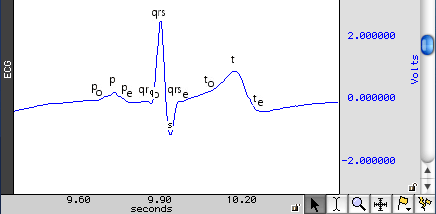
Automated Noninvasive Blood Pressure Analysis– Use the NIBP100D Noninvasive Blood Pressure System to automatically record noninvasive blood pressure. The NIBP100D system attaches to the finger of a human subject to output a continuous blood pressure signal, and is ideal for short and long-term exercise studies. Automatically calculate and display values for systolic, diastolic, mean blood pressure, and heart rate. Export the data directly to a spreadsheet, graph channels, text format or all three.
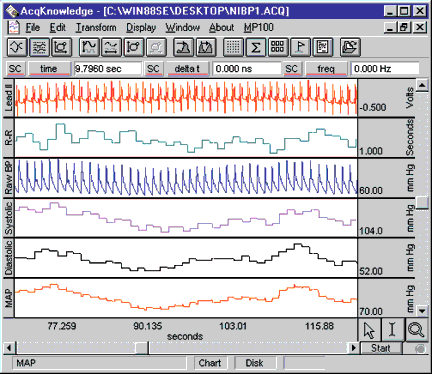
Advanced Features Spotlight
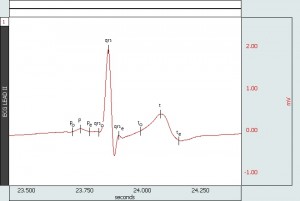
AcqKnowledge provides a fully-automated ECG analysis system. The software automatically identifies and labels the points of the ECG complex. It also calculates the amplitudes and More...
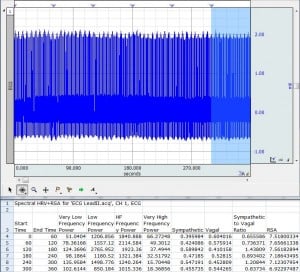
Heart Rate Variability (HRV) Analysis Software
AcqKnowledge® includes a series of automated Heart Rate Variability (HRV) analysis tools that conform to international cardiology standards. It is possible to perform the analysis More...
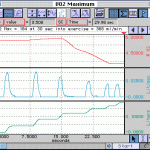
Maximal Oxygen Consumption (VO2 max)
Maximal oxygen consumption measurements nominally incorporate the use of a mixing chamber (AFT15A/B), facemask with non-rebreathing T valve (AFT25) and an air flow transducer (TSD107B). More...
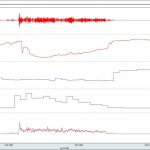
Record microvascular oxygenation during muscle activation Sample Data download → fNIR_EMG.zip (extract biceps_EMG_fnir_demo.acq) Using functional Near Infrared (fNIR) to study muscle function can provide greater understanding of the More...
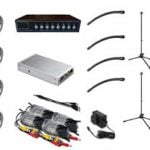
Camera Systems - Multi-Subject Monitoring
New Multi-Subject Video Monitoring Systems BIOPAC now offers multi-subject video monitoring systems. The new Camera Systems record multiple subjects or camera angles and AcqKnowledge media More...
Support
Application Notes
- 101 - Transducer Calibration and Signal Re-Scaling
- 114b - Pneumotach Transducer - TSD107B
- 135 - Pneumotach Transducer - TSD117
- 140 - Goniometers: Angular Measurements
- 141 - Tri-axial Accelerometer Calibration - TSD109 series or SS26/27
- 145 - Respiratory Effort Transducer - TSD101B
- 154 - High Level Transducer Connections - HLT100C
- 159 - Hand Switch and Foot Switch - TSD116 Series
- 186 - Variable Assessment Transducer - TSD115
- 109 - 3-, 6-, and 12-Lead ECG
- 110 - Amplifier Baseline Offset Adjustment
- 126 - Wireless Remote Monitoring - TEL100C-RF
- 136 - Battery Pack Instructions - BAT100
- 149 - O2100C Module Setup for the MP System
- 151 - CO2100C Module Setup for the MP System
- 160 - Gas Analysis Module Response Time
- 162 - Stimulation Features of MP160/150/100 Systems
- 175 - Stimulus Isolator Guidelines - STMISOC
- 185 - iMac and G3 Compatibility Issues
- 195 - MP System Data Sampling Reference
- 196 - Cardiac Output Measurement - EBI100C
- 206 - Continuous 12-Lead ECG
- 207 - UDP Install: MP150 + No Network Access
- 208 - UDP Install: MP150 + Domain Network Access
- 209 - UDP Install: MP150 + Network Access or Multiple Computers
- 215 - Noninvasive Cardiac Ouput - NICO100C
- 111 - Nerve Conduction Velocity
- 115 - Hemodynamic Measurements
- 120 - X/Y Loop Area Analysis
- 121 - Waveform Data Reduction
- 122 - Power Spectrum Analysis
- 129 - Heart Rate Variability
- 142 - Rate Detector Algorithm in AcqKnowledge
- 143 - Importing AcqKnowledge Data Into Excel
- 148 - Automated ECG Analysis
- 150 - O2100C Module for Oxygen Consumption
- 152 - CO2100C Module Application Example
- 155 - AcqKnowledge File Formats for the Macintosh
- 156 - AcqKnowledge File Formats for PC With Windows
- 158 - Analyzing Inspired & Expired Lung Volume
- 177 - ECG Analysis Using the Offline Averaging Mode
- 183 - VO2 and RER Measurement
- 191 - Digital I/O Channels
- 200 - Creating Arbitrary Waveforms for the MP Systems Stimulator
- 204 - AcqKnowledge Peak Detector Operation
- 218 - Hardware API
- 219 - Known Issues - AcqKnowledge
- 221 - Simplified VO2 Measurement (Without CO2 Values)
- 118 - EMG Signal Analysis
- 130 - Blood Pressure Measurement for the BSL PRO
- 102 - Biopotential Amplifier Testing With CBLCAL
- 232 - EMG: Normalize to Maximum Voluntary Contraction - BSL PRO
- 001 - AcqKnowledge Release and OS Compatibility
- 261 - TSD250 (BPS-II) VMG transducer in the assessment of isometric absolute muscle effort
- 262 - VMG to assess quad-hamstring activity after ACL tear
- 266 - Tri-axial Accelerometer Measurements using BioNomadix
- 268 - Metabolic Analysis Systems and Propane-based Verification
- 270 - Synchronizing Physiology Data Recording with Associated Video
- 273 - Use BioNomadix Accelerometer as Tilt Sensor or Inclinometer
- 275 - Dynamometers for Low Hand Grip Strength Measurements
- 288 - How to Turn Events into Graph Channels
- 296 - Continuous Monitoring of a Monotonic Signal for GASSYS3
- 298 - Getting Started with Workflow
Knowledge Base
- * CLEANING GUIDELINES *
- AC mode
- AcqKnowledge accuracy
- AcqKnowledge backwards compatibility
- AcqKnowledge: Newest Features
- AFT11 Series coupler guide
- Amplifier baseline offset adjustment
- Amplifier conversion - 2 mm to touchproof
- Amplifier filter settings
- Arbitrary waveform stimulation
- Audio recording synchronization
- Band-pass and band-stop filters
- Bioimpedance Methods
- Biopotential amplifier signal validation
- Buffer overflow
- Calculating file sizes
- Calibration values
- Combining Video with AcqKnowledge
- Common mistakes/general troubleshooting
- Connecting Calibration Gas Tanks & Mixing Chambers
- Connecting the TSD116C Switch Box
- Copy and paste append markers along with data
- DA100C amplifier signal validation
- DC mode
- Deep breath and PPG signal flattening
- Differences between the NICO100C and EBI100C
- Duplicating waveforms
- ECG Analysis
- ECG artifact in EMG Signal
- ECG R-wave detector
- Editing noisy data
- Electrical stimulation and artifact
- Electrode Properties - gel and adhesive
- Excel files exported from BIOPAC software open in Excel 'Protected View'
- Exporting Data to SPSS
- External Devices and Channel Contention
- Extracting data segments from a file
- Extracting heart rate from a noisy ECG signal
- Grounding guidelines
- Height/Weight entries for CO using Kubicek/Rho method
- High pass filters
- IIR vs. FIR filters
- Interfacing third-party transducers
- Inverted Waveform
- LabView interface
- Loading Physiobank data files
- Low pass filters
- Magnetic stimulation artifacts
- MP150 UDP protocol fixed IP address
- MRI - Triggering
- Multiple amplifiers per subject or multiple subjects per system
- NIBP100A sensor height & signal output
- NIBP100A single pulse data analysis
- Notch filter
- Optimal ground placement
- Outputting a signal through the STM100C
- Physiological measurements - life science signals using BIOPAC
- PPG setup and calibration
- Railing signal (flatline)
- Recording good data
- Respiration recording
- Text files - import and export
- Upgrading from PCMCIA to USB
- USB Drivers and Controller Communication
- Using other software with BIOPAC hardware
- Volume from airflow
- VREF, reference excitation voltage
Stay Connected